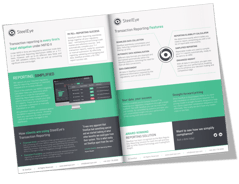 Regulatory change in financial services is happening at such a rapid rate that projects can often end up focussing on completing the requirements for just one package of rules at a time, as firms rush to achieve compliance. However, many rules are actually quite similar in the data required so it can be helpful to take a look at two sets of requirements side-by-side, and to consider their data requirements and challenges. Doing so can enable firms to recognise synergies, where one data set can empower multiple obligations.
Regulatory change in financial services is happening at such a rapid rate that projects can often end up focussing on completing the requirements for just one package of rules at a time, as firms rush to achieve compliance. However, many rules are actually quite similar in the data required so it can be helpful to take a look at two sets of requirements side-by-side, and to consider their data requirements and challenges. Doing so can enable firms to recognise synergies, where one data set can empower multiple obligations.
In this blog, we will look at both the European Market Infrastructure Regulation (EMIR) and the Markets in Financial Instruments Directive II (MiFID II). We’ll explore the differences between EMIR and MiFID II, as well as their similarities, which can help organisations to think more strategically about how they approach their compliance obligations.
Topics covered in this blog:
What is EMIR and MiFID II?
What is EMIR?
 EMIR is a EU regulation designed to improve the management of credit and operational risk within the OTC derivatives markets, and to enable regulators to reduce overall systemic risk.
EMIR is a EU regulation designed to improve the management of credit and operational risk within the OTC derivatives markets, and to enable regulators to reduce overall systemic risk.
The regulation requires both financial and non-financial counterparties to clear OTC derivatives transactions through central clearing counterparties (CCPs), or else apply specific risk mitigation processes.
Derivatives transactions then need to be reported to trade repositories, which publish reports of the data to the regulators. These regulatory requirements aim to reduce the counterparty credit risk associated with non-cleared transactions and mitigate operational risk through electronic systems. The increased transparency around OTC derivatives transactions also enables the regulators to monitor these markets in depth.

|
EMIR REPORTING
Meet your EMIR reporting requirements with an automated and intelligent EMIR reporting solution.
LEARN MORE
|
What is MiFID II?
 Overall, MiFID II is designed to make the EU capital markets more resilient, transparent, and investor-friendly.
Overall, MiFID II is designed to make the EU capital markets more resilient, transparent, and investor-friendly.
It is a regulation developed from MiFID I, which according to the EU focused on providing:
-
organisational and conduct of business rules for investment firms
-
authorisation requirements for regulated markets
-
regulatory reporting to detect and prevent market abuse
-
trade transparency reporting for shares
-
requirements for the admission of financial instruments to trading
MiFID II – which included the Markets in Financial Instruments Regulation (MiFIR) and substantial technical standards – made significant changes to the original rules, including:
-
Widening the scope beyond equities to bonds, structured finance products, emission allowances and derivatives.
-
Strengthening best execution requirements
-
Unbundling research
-
Providing enhanced regulation of high-frequency trading
-
Requiring much more extensive pre- and post-trade reporting

Through the MiFID II requirements, regulators are aiming to strengthen the capital markets by reducing market abuse, conflicts of interest, and other issues that had historically resulted in sub-optimal outcomes for customers and the markets.

|
MIFID II REPORTING
Automated, optimised and reliable transaction reporting solution.
LEARN MORE
|
How do EMIR and MiFID II compare?
At first glance, there are a number of key differences between EMIR and MiFID II, highlighted in the table below, however, there are several similarities between EMIR and MiFID II, too. For example, both require the same types of transaction data to be reported to the regulator, both on a T+1 basis – which means that firms have to report by the end of the day today all transactions from yesterday.
Yet, many financial services firms have created two different data management and reporting processes to tackle these different sets of obligations, because they were implemented at different times. Of course, not all firms are in scope for both regimes, but for those that are this is a common trend.
Key differences between EMIR and MiFID II
|
|
EMIR
|
MiFID II
|
|
Came into effect
|
2013
|
2018
|
|
Scope
|
OTC derivatives
|
Equities, bonds, structured finance products, emission allowances, and derivatives
|
|
Reporting requirements
|
All counterparties to a derivative transaction have to report their details to a Trade Repository in T+1
|
Transactions must be reported to an Approved Publication Arrangement (APA) in near real-time and to an Approved Reporting Mechanism (ARM) on a T+1 basis
|
How do EMIR and MiFID II work?
 EMIR and MiFID II constitute complex pieces of financial services rulemaking that focus on using data and analytics to meet their supervisory goals. Regulators believe that improved access to data can help them better understand where risks may be accumulating within the financial system, or how individuals may be engaging in market abuse.
EMIR and MiFID II constitute complex pieces of financial services rulemaking that focus on using data and analytics to meet their supervisory goals. Regulators believe that improved access to data can help them better understand where risks may be accumulating within the financial system, or how individuals may be engaging in market abuse.
Under EMIR OTC derivatives transactions are reported by the counterparties to trade repositories. Trade repositories collect this data and store it for use by the regulators’ analytics systems. However, in the European Securities Market Authority (ESMA’s) April 2021 report, EMIR and SFTR data quality report 2020, significant issues with the quality of the data being submitted by the counterparties were identified.
Under MiFID II, post-trade data, such as the price, volume, and time of the transaction must be submitted to an APA. Also, much more detailed post-trade transaction reports must be sent to a ARM.
Difference between MiFIR APA and ARM reporting:
Under MiFID II there are two types of regulatory reporting, trade reporting and transaction reporting. Trade reporting happens to the market and is designed to increase transparency and level the playing field between market participants. It requires firms to report eligible transactions in near real-time to an APA. Transaction reporting on the other hand is done to the regulator and happens on the T+1 basis via an ARM in order to help regulators detect and investigate suspected market abuse.
Both EU and UK regulators have repeatedly highlighted data quality challenges here, too.
When was EMIR and MiFID II introduced?
EMIR came into force on 13 March 2013, while MiFID II went live on 1 January 2018. The original MiFID I became applicable in November 2007.
 EMIR was created and MiFID updated as a result of the global financial crisis of 2008. During the crisis, OTC derivative markets suffered because of a lack of transparency around counterparties and the clearing of trades – exacerbating the emergency. In addition, it became apparent that forms of market abuse had been taking place prior to the crisis, while certain conflicts of interest within firms had led to practices that were not in the customers’ best interests. These issues had undermined market integrity and contributed to the enormous scale of the Financial Crisis.
EMIR was created and MiFID updated as a result of the global financial crisis of 2008. During the crisis, OTC derivative markets suffered because of a lack of transparency around counterparties and the clearing of trades – exacerbating the emergency. In addition, it became apparent that forms of market abuse had been taking place prior to the crisis, while certain conflicts of interest within firms had led to practices that were not in the customers’ best interests. These issues had undermined market integrity and contributed to the enormous scale of the Financial Crisis.
Who does EMIR and MiFID II apply to?
EMIR applies to the jurisdictions of the European Economic Area (the EEA), which includes the EU Member States plus Iceland, Liechtenstein and Norway. If one counterparty is within the EEA and the other is not, the OTC derivatives trade will need to abide by both EMIR and the rules of the other country.
MiFID II applies to financial services firms undertaking activities captured in MiFID anywhere in the EEA. It impacts all participants in the EU's financial markets, whether they are based in the EU or elsewhere.
Current challenges
What challenges do EMIR and MiFID II present to firms today?
Both EMIR and MiFID II requirements present a number of similar challenges to the organisations that have to comply with the EU rule sets, or their equivalent in the UK, including:
-
Regulatory change –EMIR was updated with a series of changes known as EMIR II or EMIR REFIT in May 2019, with some further tweaks, known as EMIR 2.2, on 1 January 2020. The EU may look to alter MiFID II as well, with a potential MiFID 2.5 or 3.0 on the horizon. The industry can expect further EU rule changes over time, to support the evolution in the markets.
-
 Brexit – As both EMIR and MiFIR II were originally created by the EU, they had to be transferred into UK law as a result of Brexit. For EMIR, the UK is so far remaining closely aligned to the EU text and has committed to implementing certain future elements of EMIR II/EMIR Refit that were not in place on 31 December 2020. Meanwhile, the UK made some “quick fixes” to MiFID II when it transposed it for Brexit, and the EU is likely to make changes to its own version. So, looking forward, the more regulatory divergence between the UK and the EU is likely for these two rulesets, creating potential compliance headaches.
Brexit – As both EMIR and MiFIR II were originally created by the EU, they had to be transferred into UK law as a result of Brexit. For EMIR, the UK is so far remaining closely aligned to the EU text and has committed to implementing certain future elements of EMIR II/EMIR Refit that were not in place on 31 December 2020. Meanwhile, the UK made some “quick fixes” to MiFID II when it transposed it for Brexit, and the EU is likely to make changes to its own version. So, looking forward, the more regulatory divergence between the UK and the EU is likely for these two rulesets, creating potential compliance headaches.
-
Data quality – Both in the EU and in the UK, regulators have been highlighting data quality issues in the trade data reporting regimes of both EMIR and MiFID II for some time now. Regulatory patience is wearing thin. Before the Covid-19 pandemic, regulators had started to issue public reprimands and fines to firms – some of the firms’ infractions spanned multiple years. During the pandemic, regulators relegated themselves to issuing warnings about data quality, but as Covid-19 subsides, it is likely that more enforcement action is in the cards.
-
 Data management – The quality of the data reported to regulators is uneven because of the data management challenges that still exist. Firms can have multiple legacy systems across business lines and geographies that they harvest data from, to report under EMIR and MiFID II. Data governance can be sub-optimal, while cleaning and normalising the data can still involve manual processes resulting in manual errors.
Data management – The quality of the data reported to regulators is uneven because of the data management challenges that still exist. Firms can have multiple legacy systems across business lines and geographies that they harvest data from, to report under EMIR and MiFID II. Data governance can be sub-optimal, while cleaning and normalising the data can still involve manual processes resulting in manual errors.
Looking ahead
What is the future of both EMIR and MiFID II?
Like movies in the cinema, there will be sequels to both sets of regulations. These rules contain imperfections that need to be hammered out, and the markets they cover are changing constantly. Also, Brexit will result in a certain amount of regulatory divergence over time. Most firms now find themselves in a constant state of regulatory change, and this is going to continue through the near future.
To thrive in this kind of environment, many compliance teams within financial services firms are turning away from a requirement-focused approach to a data-centric compliance strategy. By applying data governance best practices such as automating data collection and normalisation and storing all the data in one golden source, firms are finding that reporting becomes much less resource intensive, and regulatory change much easier to accomplish.
 |
Let us show you how we simplify compliance
We’ll give you a tour of our platform, so you can see how data-driven compliance drives better results.
|

 Regulatory change in financial services is happening at such a rapid rate that projects can often end up focussing on completing the requirements for just one package of rules at a time, as firms rush to achieve compliance. However, many rules are actually quite similar in the data required so it can be helpful to take a look at two sets of requirements side-by-side, and to consider their data requirements and challenges. Doing so can enable firms to recognise synergies, where one data set can empower multiple obligations.
Regulatory change in financial services is happening at such a rapid rate that projects can often end up focussing on completing the requirements for just one package of rules at a time, as firms rush to achieve compliance. However, many rules are actually quite similar in the data required so it can be helpful to take a look at two sets of requirements side-by-side, and to consider their data requirements and challenges. Doing so can enable firms to recognise synergies, where one data set can empower multiple obligations. EMIR
EMIR
 Overall,
Overall, 

 EMIR and MiFID II constitute complex pieces of financial services rulemaking that focus on using data and analytics to meet their supervisory goals. Regulators believe that improved access to data can help them better understand where risks may be accumulating within the financial system, or how individuals may be engaging in market abuse.
EMIR and MiFID II constitute complex pieces of financial services rulemaking that focus on using data and analytics to meet their supervisory goals. Regulators believe that improved access to data can help them better understand where risks may be accumulating within the financial system, or how individuals may be engaging in market abuse. EMIR was created and MiFID updated as a result of the global financial crisis of 2008. During the crisis, OTC derivative markets suffered because of a lack of transparency around counterparties and the clearing of trades – exacerbating the emergency. In addition, it became apparent that forms of market abuse had been taking place prior to the crisis, while certain conflicts of interest within firms had led to practices that were not in the customers’ best interests. These issues had undermined market integrity and contributed to the enormous scale of the Financial Crisis.
EMIR was created and MiFID updated as a result of the global financial crisis of 2008. During the crisis, OTC derivative markets suffered because of a lack of transparency around counterparties and the clearing of trades – exacerbating the emergency. In addition, it became apparent that forms of market abuse had been taking place prior to the crisis, while certain conflicts of interest within firms had led to practices that were not in the customers’ best interests. These issues had undermined market integrity and contributed to the enormous scale of the Financial Crisis. Brexit – As both EMIR and MiFIR II were originally created by the EU, they had to be transferred into UK law as a result of Brexit. For EMIR, the UK is so far remaining closely aligned to the EU text and has committed to implementing certain future elements of EMIR II/EMIR Refit that were not in place on 31 December 2020. Meanwhile, the UK made some “quick fixes” to MiFID II when it transposed it for Brexit, and the EU is likely to make changes to its own version. So, looking forward, the more regulatory divergence between the UK and the EU is likely for these two rulesets, creating
Brexit – As both EMIR and MiFIR II were originally created by the EU, they had to be transferred into UK law as a result of Brexit. For EMIR, the UK is so far remaining closely aligned to the EU text and has committed to implementing certain future elements of EMIR II/EMIR Refit that were not in place on 31 December 2020. Meanwhile, the UK made some “quick fixes” to MiFID II when it transposed it for Brexit, and the EU is likely to make changes to its own version. So, looking forward, the more regulatory divergence between the UK and the EU is likely for these two rulesets, creating  Data management – The quality of the data reported to regulators is uneven because of the data management challenges that still exist. Firms can have multiple legacy systems across business lines and geographies that they harvest data from, to report under EMIR and MiFID II. Data governance can be sub-optimal, while cleaning and normalising the data can still involve manual processes resulting in manual errors.
Data management – The quality of the data reported to regulators is uneven because of the data management challenges that still exist. Firms can have multiple legacy systems across business lines and geographies that they harvest data from, to report under EMIR and MiFID II. Data governance can be sub-optimal, while cleaning and normalising the data can still involve manual processes resulting in manual errors.






